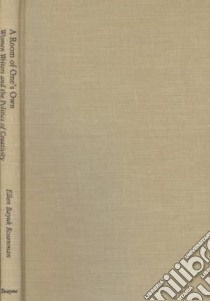A Room of One's Own - 9780805783742
Un libro in lingua di Rosenman Ellen Bayuk edito da Twayne Pub, 1994
- € 69.10
- Il prezzo è variabile in funzione del cambio della valuta d’origine
With its theme of autonomy and independence, Virginia Woolf's 1929 essay A Room of One's Own has become part of our modern cultural vocabulary. It was the first literary history of women writers and the first theory of literary inheritance in which gender was the central category. As a theory of women's literature, it presents general ideas and issues through which the lives and works of women writers might profitably be read. Woolf (in the persona of narrator) does not offer extended readings of individual literary works but speculates about why and how women wrote as they did - which has proved infinitely more valuable to twentieth-century critics attempting to map out the new terrain of women's literature. A Room of One's Own is much more than a historical landmark of feminist criticism: remarkably, it has served the needs of various strains of feminist criticism, not all of them compatible with each other.
In this balanced and insightful study, Ellen Bayuk Rosenman explores the myriad perceptions of a work whose famous title comes from one of its most basic and simple prescriptions: that to fare as a writer in the modern world a woman needs a room of her own and [pound]500 a year. In a broad sense, Rosenman points out, A Room of One's Own analyzes the constraints on women's achievement - the hostile environment in which they write - and the responses, both creative and self-defeating, that this environment provokes. This environment - the historically ordered patriarchy - Rosenman observes as Woolf observed it, from the place of the outsider. Rosenman follows the essay's analysis of what she considers two large and vague words: patriarchy and feminism.
In various chapters Rosenman discusses the essay's exploration of sociology of creativity; of male social institutions - namely, Oxford and Cambridge universities and the British Museum - as gateways at which the initiated are separated from the outsiders; and of female creativity and literary history. Rosenman also pays special attention to the essay as novel, showing how the twists and turns of Woolf's narrative in A Room of One's Own - her creation of a shadowy persona and her heavy use of irony - resemble experimental literary techniques. Rosenman concludes her engaging analysis with a summation of the "blind spots" of Woolf's masterwork.
Along with preliminary chapters discussing the essay in the context of Woolf's own history and how it was received by critics, Rosenman devotes a fascinating chapter to the importance of the very new and few women's colleges in England at the time Woolf wrote A Room of One's Own, which derived from speeches she gave at the two women's colleges in Oxford a year before.
Informazioni bibliografiche
- Titolo del Libro in lingua: A Room of One's Own
- Sottotitolo: Women Writers and the Politics of Creativity
- Lingua: English
- Autore: Rosenman Ellen Bayuk
- Editore: Twayne Pub
- Collana: Twayne Pub (Hardcover)
- Data di Pubblicazione: 01 Novembre '94
- Genere: LITERARY CRITICISM
- Argomenti : Feminism and literature England History 20th century Women and literature England History 20th century Creative ability Political aspects
- Dimensioni mm: 152 x 228 x 25
- ISBN-10: 0805783741
- EAN-13: 9780805783742


